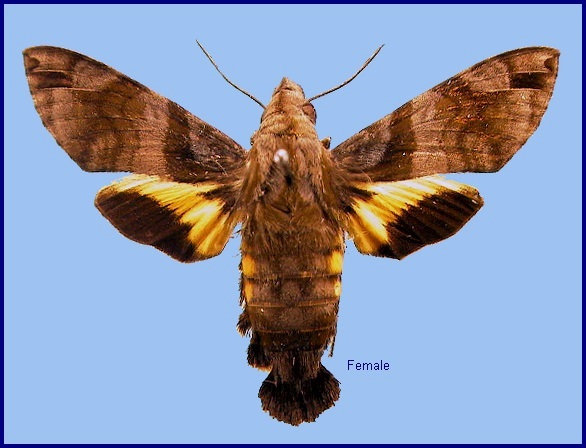
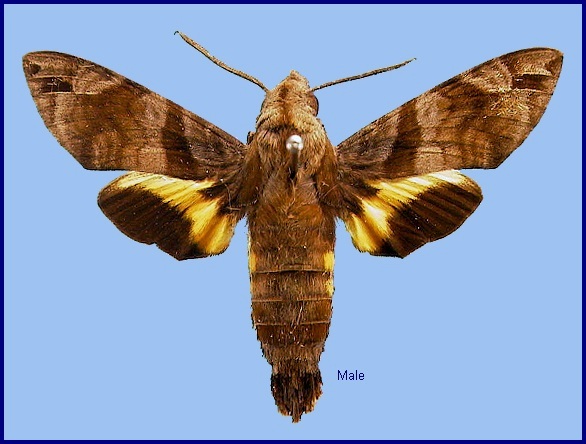
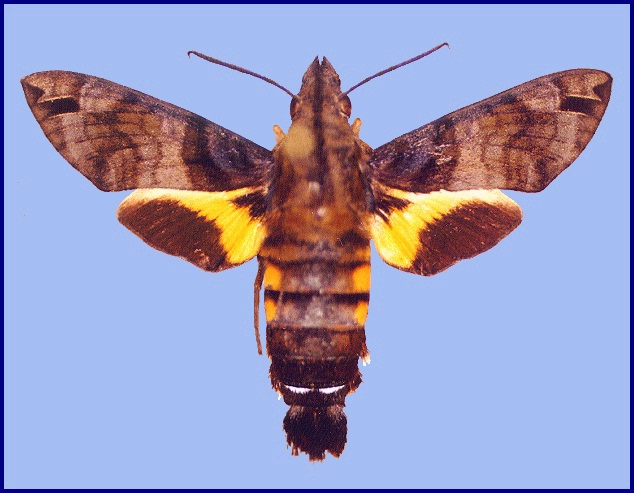
Macroglossa pyrrhosticta Butler, 1875, Proc. zool. Soc. Lond. 1875: 242. Type locality: China, Shanghai.
Synonym. Macroglossa catapyrrha Butler, 1875.
Synonym. Macroglossum pyrrhosticta albifascia (Mell, 1922).
Synonym. Macroglossum pyrrhosticta ferrea (Mell, 1922).
Synonym. Macroglossum fukienensis Chu & Wang, 1980, Acta zootaxon. sin. 5: 420. Type locality: China, Fujian, Jianyang.
[Further details on this species in Japan, as well as photos of many stages, can be found on Digital Moths of Japan as well as Moths of the southern Shikoku, Japan.]
Wingspan: 42--56mm. Very similar to Macroglossum troglodytus Boisduval, 1875, but usually slightly larger. Forewing upperside with pattern of lines similar to that of Macroglossum troglodytus, but the antemedian band and first discal line further apart, the grey spaces between the lines duller and more olive green, the wings thus appearing less variegated. The undersides of both sets of wings are bright rust-coloured as in Macroglossum troglodytus, as is the underside of the abdomen.
Male genitalia very similar to those of Macroglossum troglodytus, but the upper lobe of the harpe tapered, without, or with few teeth on the dorsal edge; process of phallus longer and pointed.
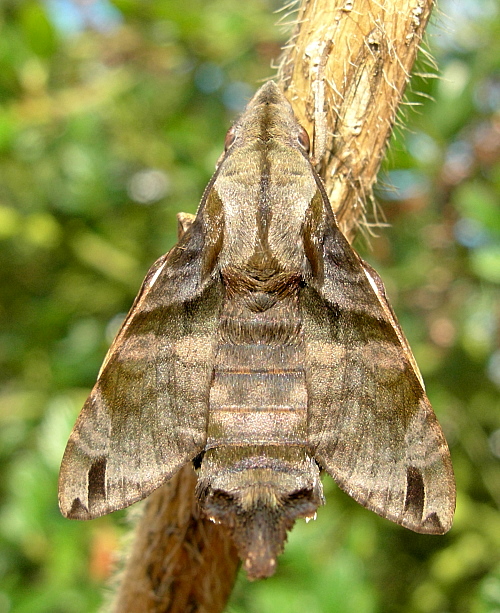
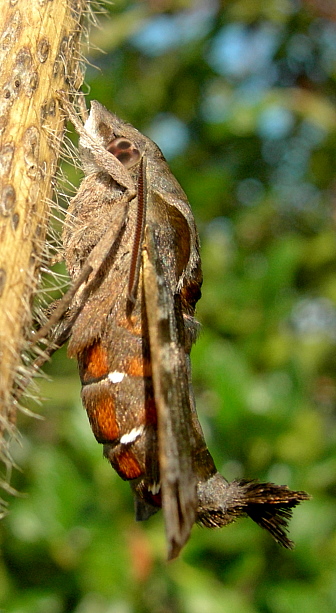
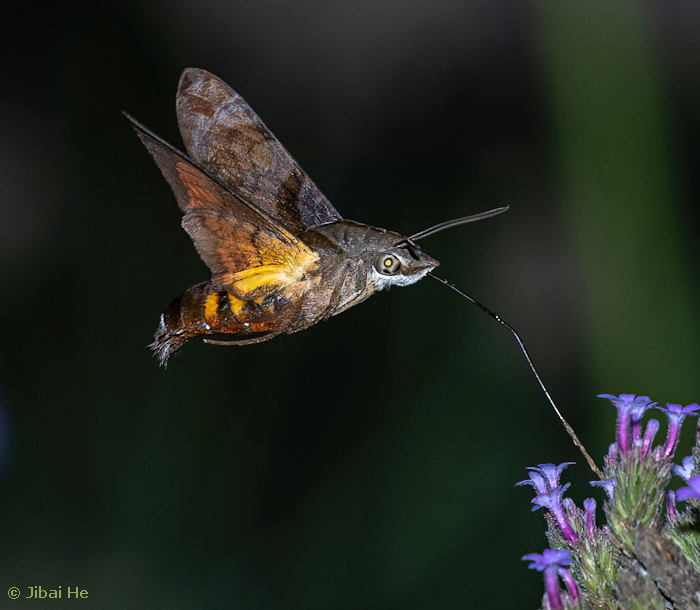
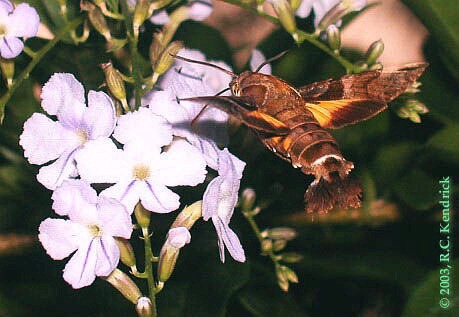
A widespread species found in many types of open habitats, even mountain meadows and logged woodland. Some adults will come to light, but most frequent flowers, particularly Duranta erecta. Has also been found in September at Persicaria thunbergii (Siebold & Zucc.) H. Gross [syn. Truellum thunbergii] on Kunashir Island, Kurile Islands (Vladimir Dubatolov, pers. comm. 2024).
China: 31.v (Guangdong); vi (Hubei); vi-vii (Sichuan; Hainan); vii (Shanghai; Jiangxi; Hunan; Fujian); vii-x (Zhejiang); viii (Guangdong; Yunnan; Zhejiang); ix (Sichuan); ix-xi (Hong Kong). Taiwan: iv-v (Kaohsiung Hsien); v (Nantou Hsien); vi (Taipei); vii (Tainan Hsien; Pingtung Hsien); xi (Pingtung Hsien); xii (Taipei). Japan: ii-x (Ryukyu Archipelago); 18.v-14.vi (Hahajima); 20.vi-28.viii (Hokkaido); viii-x (Honshu; Hahajima; Kyushu); 6.x (Shikoku). Russia: 30.vii (Kurile Islands); 3-16.viii (Primorskiy Krai); 26-31.viii (Kurile Islands); 1-20.ix (Kurile Islands).
Park et al. (1999) give late June until late October as the flight period in Korea.
OVUM: Pale transluscent white/grey when freshly laid, turning greenish-yellow with age. Slightly oval, shiny and smooth. Laid singly on the underside of younger leaves.
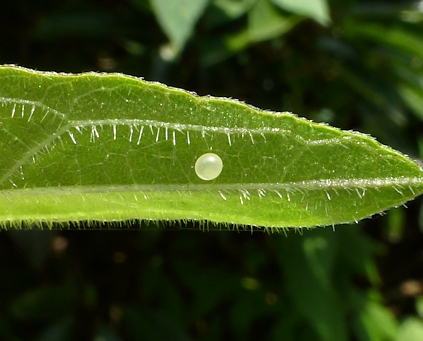
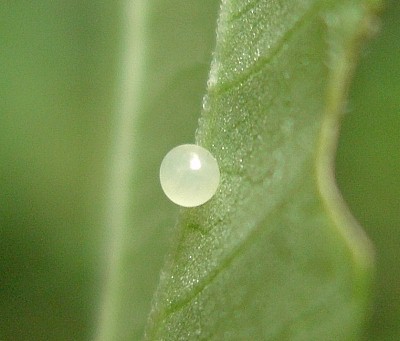
LARVA: Full-fed 50mm.; breadth 9.5 mm.; horn 7 mm. According to Bell & Scott (1937), in the final instar horn slightly curved, of medium length, tapering evenly to a sharp point, minutely tuberculate. Surface dull and smooth. A rather thick-set, stout larva. [A plate from Butler (1876)]
First and second instar larvae are slate grey with a dark horn, and very shiny. With growth the whole body becomes greener, patterned and tuberculate. In the final instar, head dark green. Body with a pale subdorsal and a pale dorso-lateral stripe from head to horn. Segments 2-4 more apple-green, but the rest of the body pale bluish-green (even paler dorsally). Covered with encicling bands of widely spaced white spots, giving the body a speckled appearance. The dorso-lateral stripe is yellow on segments 2-4, white on the remaining segments, and edged above with green. Above this stripe there are a number of short narrow stripes dorsally, which disappear on each side of the dorsal line, thus leaving a subdorsal stripe of the body-colour. There are seven narrow, greenish oblique lateral stripes. The black-tubercled horn is purplish (bluish dorsally) with the terminal third yellowish-orange. Legs reddish, basal segment with a shiny black band. Spiracles white, with a broad red band across the middle.
Although smaller larvae prefer resting under leaves, larger larvae are to be found on the twining stems of the hostplant, often deep among the foliage. Creepers growing in and on dense shaded shrubs, or over fences under overhanging trees, are preferred during the hot summer months. The larval presence is generally given away by denuded leading shoots, as young leaves are preferred.
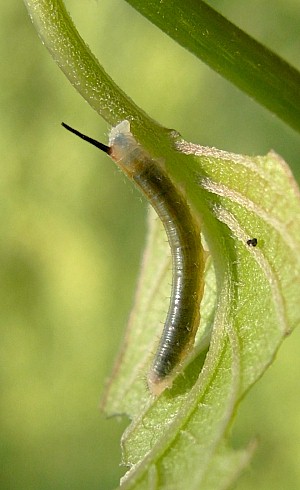
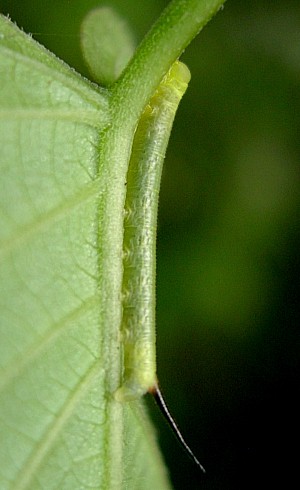
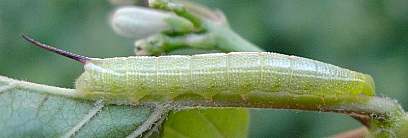
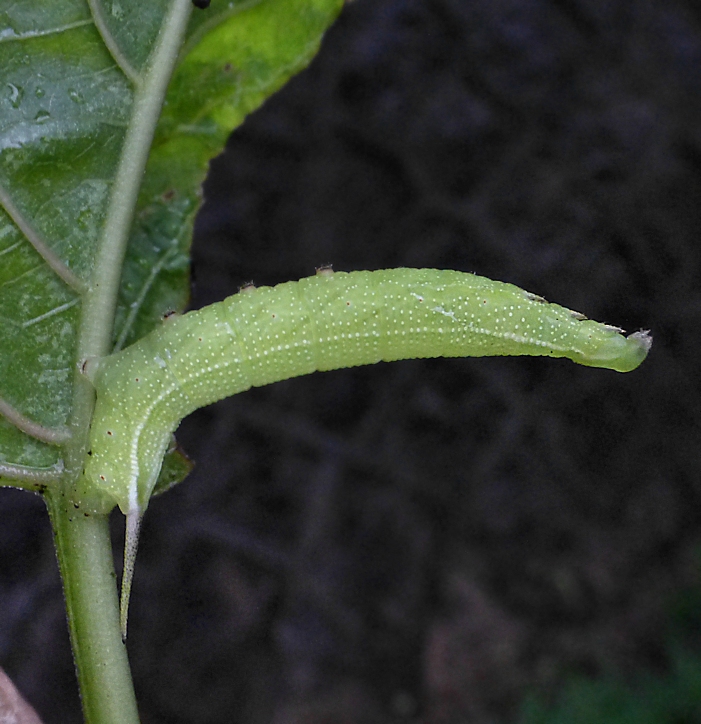
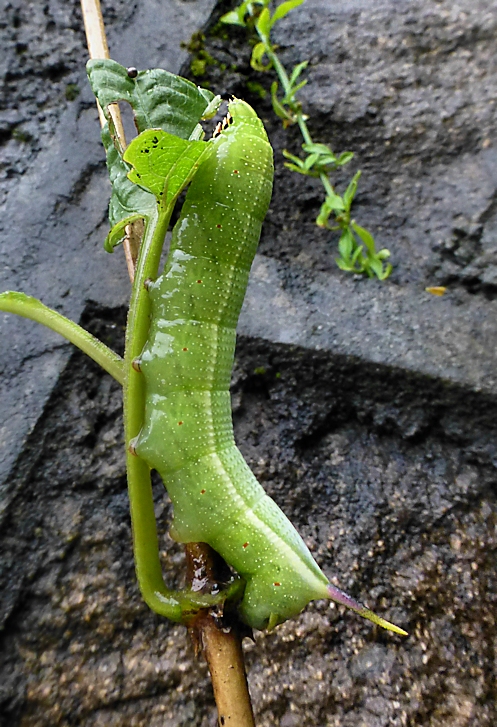
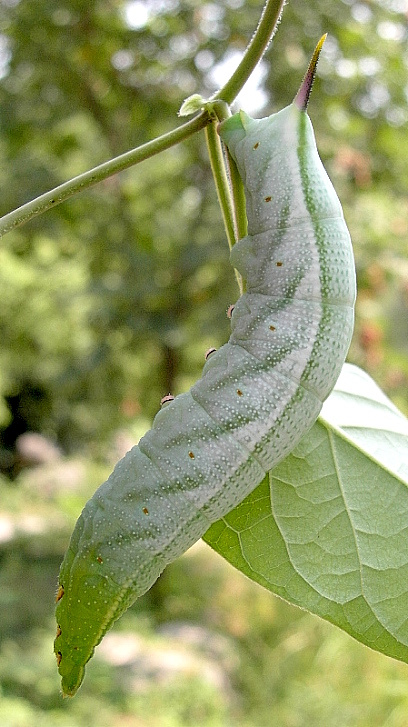
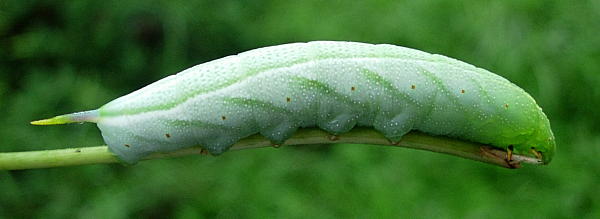
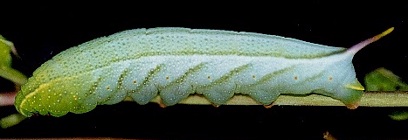

PUPA: 40mm.; breadth 11mm. Colour transluscent greyish-yellow, with a green tinge on head, thorax and wing-case, sparsely dotted with brown. Thorax with a narrow black dorsal stripe, continued as a greyish stripe (heart line) on abdomen. Tongue, inner margin of wing and spiracles black; cremaster with basal half brown above, rest black. Tongue-case beyond head prominent, laterally compressed, cariniform, projecting 3.5mm. frontad and ventad; the rest lying flush between the wing-cases. Antenna slightly shorter than fore leg, reaching to middle of wing-case. Surface of head, thorax and wing-case shiny and smooth; abdomen shiny and pitted dorsally and ventrally. Hind bevels of segments 8 to 10 smooth, front bevels of 9 to 11 with many transversely elongate tubercles. Cremaster slightly triangular, dorso-ventrally flattened, tip bifid, the arms widely separated and very fine; venter hollow, with thick lateral extensor ridges (Bell & Scott, 1937).
Formed in a weak sliken cocoon among litter on the ground.
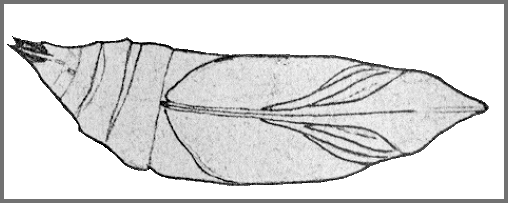

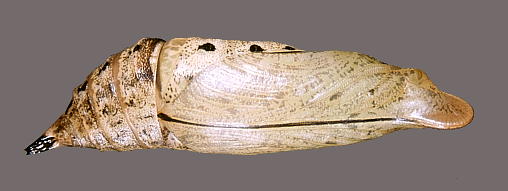
Larval hostplants. Paederia foetida and Psychotria rubra (Rubiaceae) in Hong Kong, Paederia foetida in India (Bell & Scott, 1937), and on Paederia foetida in mainland China and Taiwan. On the latter island it has also been recorded from Paederia cavaleriei, Serissa japonica [syn. Serissa serissoides] and Sida rhombifolia. It has also recently been found on Leptodermis oblonga Bunge around Beijing (Xu ZhenBang, pers. comm. 2022)
[Larger larvae will transfer to Pentas lanceolata in captivity.]
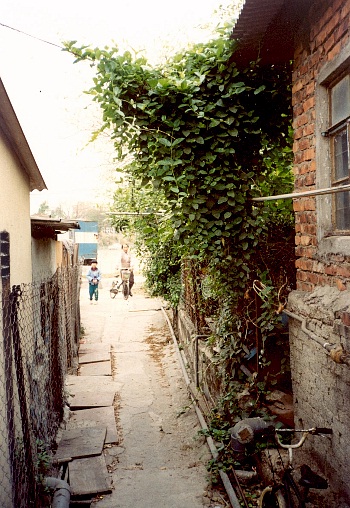
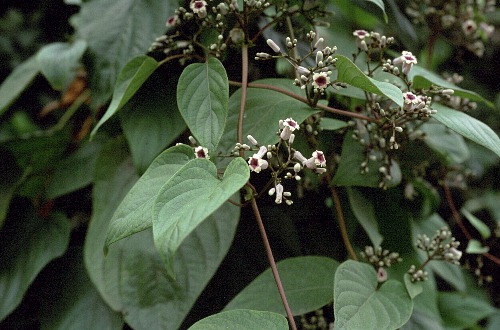
Braconidae: Meteorus stellatus Fujie, Shimizu & Maeto, 2021; Trichogrammatidae: Trichogramma chilonis Ishii, 1941, Trichogramma longxishanense Lin, 1994.
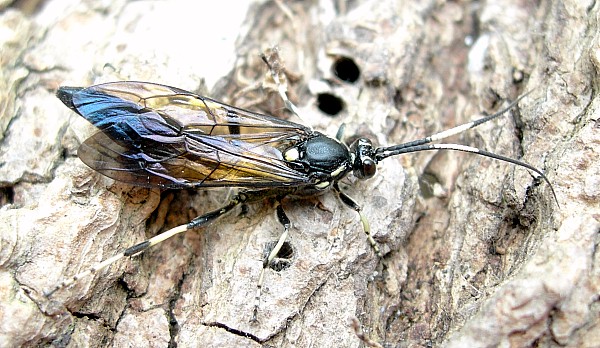
China: Beijing (Botanical Garden); Shanxi (Taiyuan); Shanghai (Jiading, 1000'); Zhejiang (Tianmu Shan; Hangzhou; Kuocang Mountain Nature Reserve; Nanji Islands National Nature Reserve, Wenzhou); Hubei (Changyang; Jiugongshan); Sichuan (Baoxing; Emei Shan, 3620'; Kangding; Chengdu; Qionglai Shan, Jiaxing; Xiaolou); Chongqing (Fengjie; Chongqing); Yunnan (Kunming; Yanmen; Menglun; Ganlanba; Simao/Pu'er; Hekou Yao Autonomous County); south Xizang/Tibet (Mutu, Namjagbarwa region, 850m (Wang, 1988); Zhangmu, 2200m; Milin, 2900m); Hunan (Yangming Shan, nr. Xintian; Chenzhou); Jiangxi (Jiujiang; Tiancun, nr. Xingguo); Fujian (Jianyang); Guangdong (Fuzhou; Nanling National Forest Park, 1100m (Morishita & Kishida, 2000)); Macau; Hong Kong; Guangxi (Guilin); Hainan (??Dwa Bi, 230m; Wuzhi Shan).
Taiwan: Tainan Hsien (Kuantzuling); Chiayi Hsien (Shuicheliao; Fenchihu); Taipei (Neihu); Taipei Hsien (Fushan; Wulai); Nantou Hsien (Puli; Lushan Spa); Kaohsiung Hsien (Shanping, 640m); Pingtung Hsien (Kenting; Sheting); Taichung Hsien (Kukuan); Hualien Hsien (Changliang-Li).
North Korea: South Hamgyong Province (Wonsan).
South Korea: Seoul (Cheongyang-ri); Kyonggi Province (Gwangleung; Suwon); North Cholla Province (Jiri-san; Namwon); South Cholla Province (Baekyang Temple; Mudeung-san; Wolchul-san; Jin-do; Geomum-do; Duryun-san; Yeosu); North Kyongsang Province (Ulleung-do); South Kyongsang Province (Pusan Hyundai; Dongrae; Geoje-do; Namhae-do; Goseong; Sancheong; Ulsan; Jinju; Hadong); Cheju Province (Cheju-do; Chuja-do; Halla-san; Biyang-do; Haean-dong; Ara-dong; Seoguipo; Sungpanak; Youngsil; Sanbang-san; Gwanglyoung; Sinsan; Soheung; Cheonjiyun; Gyolae-ri).
Japan: Hokkaido; Hahajima (Okimura; Komoriyama); Honshu (Chigasaki; Tokyo; Taira; Fujisawa; Nagano; Iruma; Yoshino; Yokohama; Kyoto); Shikoku (Onosan; Mihara); Kyushu (Kagoshima; Yuwan); Tsushima; Tanegashima; Ogasawara/Bonin Islands (Chichi-jima); Hachijo-jima (Hachijo-Fuji); Ryukyu Archipelago (Yakushima; Okinawa, Nago; Amamioshima; Ishigakishima (Kishida & Shirakawa, 1988)).
Russia: Primorskiy Krai (Primorskiy); Kurile Islands (Kunashir Island).
Northern Pakistan, northwestern India (Uttar Pradesh (Farooqi, Kitching, Parwez & Joshi, 2022)), Nepal, Bhutan (Irungbam & Irungbam, 2019), eastern India, Sri Lanka, Thailand, Vietnam (Le & Vu, 2024), central and eastern China, South Korea, North Korea, Japan, the southern Russian Far East and Kurile Islands (Dubatolov, 1991; Spitsyna & Spitsyn, 2023), Taiwan, Philippines (Luzon), Malaysia (Sarawak) and Indonesia.
A recent colonist of the Ogasawara/Bonin Islands (Takeuchi & Ohbayashi, 2006) and Hawaii, the first specimen having been recorded on the latter in 1976, from Oahu (United States Department of Agriculture, 1976; Riotte, 1977; Riotte, 1986).
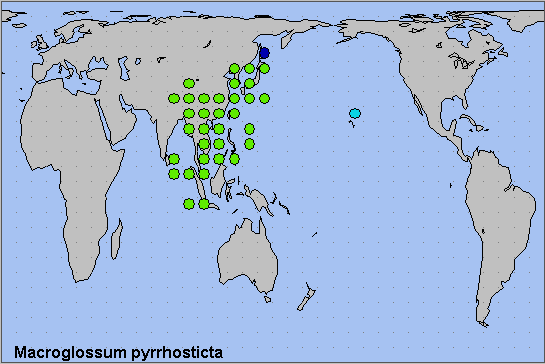
 Return to Sphingidae of the Eastern Palaearctic species list
Return to Sphingidae of the Eastern Palaearctic species list